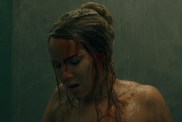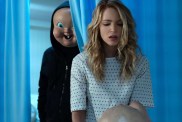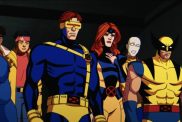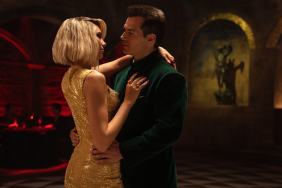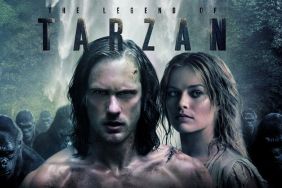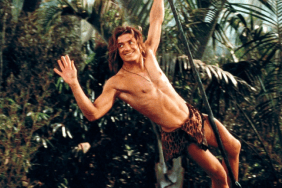It’s September 9, 2014 and we are at Warner Bros. Studios, Leavesden in the Hertfordshire area of southeastern England to visit the set of The Legend of Tarzan, Warner’s fresh take on Edgar Rice Burroughs’ classic King of the Jungle hero. While there have been numerous films based on the character over the years — including 1984’s Oscar-nominated Greystoke and Oscar-winning animated Disney film Tarzan — this is by far the largest scale adaptation of the property yet attempted, with a budget estimated at $180 million.
Rather than adapting any of the 24 books by Burroughs, screenwriters Adam Cozad and Craig Brewer have instead opted to concoct a new story that takes place in 1890 after Tarzan (Alexander Skarsgård) has left the jungle to live the aristocratic life of a London gentleman as John Clayton, 3rd Viscount Greystoke.
“It’s obviously a classic, epic tale and it’s been told many times, but it’s almost always the origin story of him growing up in the jungle,” Skarsgård explains. “In this one, although there are flashbacks to when he’s a child, the emotional journey isn’t the man from the jungle trying to adjust to life in Victorian London, it’s quite the opposite. When you first meet him he’s in England and he’s Lord Greystoke, very civilized, a British lord. Then he goes back to his emotional home, the Congo, and it’s the dichotomy between man and beast. He’s got an amazing wife, a fantastic manor, a really good life on the surface but he’s not really happy, he’s not really himself there. I think it’s something we’re all dealing with -‘Man vs Beast’- those urges. To a certain extent we’re all just animals but we’re trying to function in a modern-day society.”
Margot Robbie plays the iconic Jane, Tarzan’s wife, and rather than telling an origin story, the film takes the character back to his roots as he slowly rediscovers his wild side in order to protect African locals being enslaved by the corrupt Captain Léon Rom (Christoph Waltz). All retellings of how he came to be Tarzan as a child will be told via flashbacks.
The Legend of Tarzan is helmed by David Yates, who also directed the last four Harry Potter films here at Leavesden, a former Rolls Royce factory where planes were also built. The entire production was shot in the UK, because it was not feasible to shoot in the jungle due to the elements.
“It’s a lot easier to shoot here than to shoot in Africa,” said producer David Barron. “If you’re going to the deep rainforest you have to take everything with you, there’s no infrastructure in the rainforest, so it’s very expensive. It’s a non-productive expenditure too because it costs a lot just to get it there and keep it there. Also in proper rainforest it’s hard to move about, it’s hot, you get bitten a lot. It’s not a nice place to spend several months shooting. Visual effects technology in our days has advanced to the place that no one will ever know this is not Africa.”

Production designer Stuart Craig, who designed all the Potter films as well as Greystoke, was responsible for recreating massive jungle environments as well as African villages and other foreign locales all here on the backlot.
When we arrive it is day 56 of a 72-day shoot. As we walk through Craig’s art department we see an array of paintings on the wall depicting soldiers in pith helmets climbing a rocky ridge as villagers with bows and arrows stand above them on a waterfall. There’s a model of a colonial hut. There are planned shots of Victorian London, a treehouse, steamboats along a river, tribesmen around a fire, lots of de rigueur jungle imagery. There are photos of Djimon Hounsou in skins, warrior garb and leopard paws.
Pictures depicting Tarzan at Greystoke Manor, his ancestral home, depict a man who is not happy in suits, who yearns to return to the jungle. One dynamic piece shows Tarzan leaping onto an ape. The vision is a slightly exaggerated, romanticized version of a real jungle, with lots of fog and rainforest atmosphere, exaggerated leaves.
There are color blueprints for Captain Rom’s steamboat that list the working title as “Tarzan: The Untamed,” along with a foamcore model of a longhouse surrounded by lions on top of a steep hill. There’s a water tank at the studio where the boat will sink. Waltz’s evil Dutchman is a civil servant with his own private army working with Samuel L. Jackson‘s George Washington Williams.
“There are two stages full of jungle, and one we’ve actually changed out four times and the other one three times,” said Craig. “There are different jungle looks, vegetation, stuff like that. It’s a major piece of engineering set build.”
On F Stage there’s the Manor stables, the colonial house and a treehouse set. As we pass over the cobblestone floor we see a big painted backdrop in the stable of a stone hall with big circular windows. The Colonial house is draped in bamboo and twigs. The treehouse is falling apart, dilapidated from when he was a boy, made up of sticks, bamboo, twigs and wood tied together.
In the jungle stage the bases of moss-covered trees are MASSIVE. Atop them are rotating metal circles that cast shadows or pour rain. There’s a wooden walkway where a river will run. Vines are made of Styrofoam, plants rest in big orange pots. Think lush, green and EPIC, again with a painted backdrop as opposed to a greenscreen. It will be revamped four times to accommodate different jungle locations, with each reset taking 2 weeks.

Outside the soundstages on the backlot sits the Boma set, where there will be a wildebeest stampede towards the end of the film to bring Rom’s business down. There are big wooden buildings, the main one reading “Banque Maritime Du Congo Boma.” There are trees, a statue in a courtyard of Leopold II, blocks of rubber and a big pile of ivory tusks, all on ground of brown dirt. There’s also a massive greenscreen backdrop where the marina is. There will be water in a 250-square foot tank. There’s a pier that fell over.
Another section on the backlot depicts big, dark rock faces where Djimon’s Chief Mbonga and his warriors dwell. It’s a stone lair where Tarzan will be seen jumping off a cliff face. This section will also be filled with water. All the rocks were taken from a rubber mold made from a rock quarry in Wales, ultimately taking 12 weeks to build. It will be part of a scene in which all the tribes of Africa band together.
As if the production of The Legend of Tarzan didn’t already seem massive enough, they’re also building London’s Downing Street, which just began construction. It will be a brick street with just the bottoms of the stone buildings (the rest will be finished digitally. We also see a house on a hill in the distance, although we are not allowed to go near it because it’s rigged with explosives.
Finally, we get to see some action with the man of the hour, Tarzan. On a big greenscreen stage, there’s a train interior scene being shot with Skarsgård and Jackson looking into a compartment. Alex is attacked by train personnel but the fight is quick and efficient on Tarzan’s part, to the point that when he gets to the last attacker he literally pushes him over. Sam then pops back in.
“We’ve just landed on the roof of this train,” Skarsgård tells us. “They have a lot of slaves capture, these Belgian soldiers. It’s the first time John – who grew up out here but spent almost a decade in England – has come back to the Congo. It’s the first time he realizes what’s happened in his home, what they’re doing to his people.”
Like the lead actor, Alex’s double is dressed in a tan vest garb, and it should be noted that the two look virtually identical. Sam Jackson has a wig and glasses and a gun, and is in tip-top shape for a guy in his mid-60s.
The crew lightly shakes the train car. Alex screams — guttural animal yells — to psyche himself up. He knocks a guy out and then pushes another into the ceiling. The latter man is on a pulley that yanks him up. A lighting rig above the train creates the illusion of movement. Just then a soldier in a pith helmet walks into the compartment.
“Want me to shoot him?” Jackson asks.
Tarzan, however, takes a more hands-on approach.
Warner Bros. Pictures’ The Legend of Tarzan opens everywhere July 1.
The Legend of Tarzan
-
The Legend of Tarzan

-
The Legend of Tarzan

-
The Legend of Tarzan

-
The Legend of Tarzan

-
The Legend of Tarzan

-
The Legend of Tarzan

-
The Legend of Tarzan

-
The Legend of Tarzan

-
The Legend of Tarzan

-
The Legend of Tarzan

-
The Legend of Tarzan

-
The Legend of Tarzan

-
The Legend of Tarzan

-
The Legend of Tarzan

-
The Legend of Tarzan

-
The Legend of Tarzan

-
The Legend of Tarzan

-
The Legend of Tarzan

-
The Legend of Tarzan

-
The Legend of Tarzan

-
The Legend of Tarzan

-
The Legend of Tarzan

-
The Legend of Tarzan

-
The Legend of Tarzan

-
The Legend of Tarzan

-
The Legend of Tarzan

-
The Legend of Tarzan

-
The Legend of Tarzan

-
The Legend of Tarzan

-
The Legend of Tarzan

-
The Legend of Tarzan

-
The Legend of Tarzan

-
The Legend of Tarzan

-
The Legend of Tarzan

-
The Legend of Tarzan

-
The Legend of Tarzan

-
The Legend of Tarzan

-
The Legend of Tarzan

-
The Legend of Tarzan

-
The Legend of Tarzan

